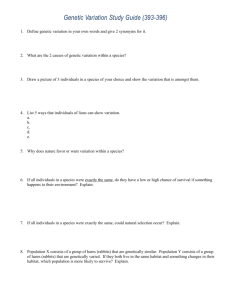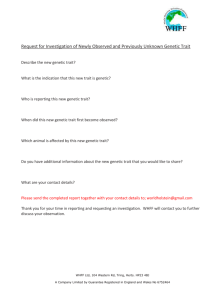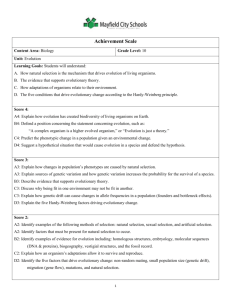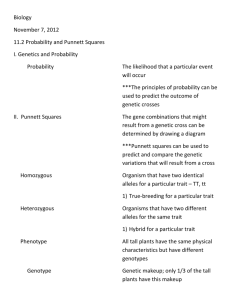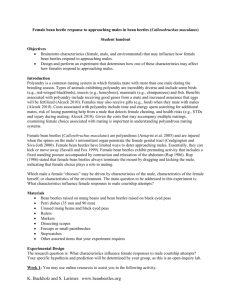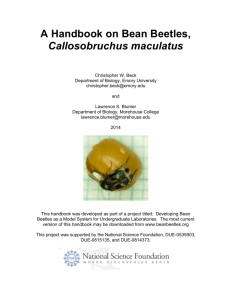Inducing Evolution in Bean Beetles
advertisement
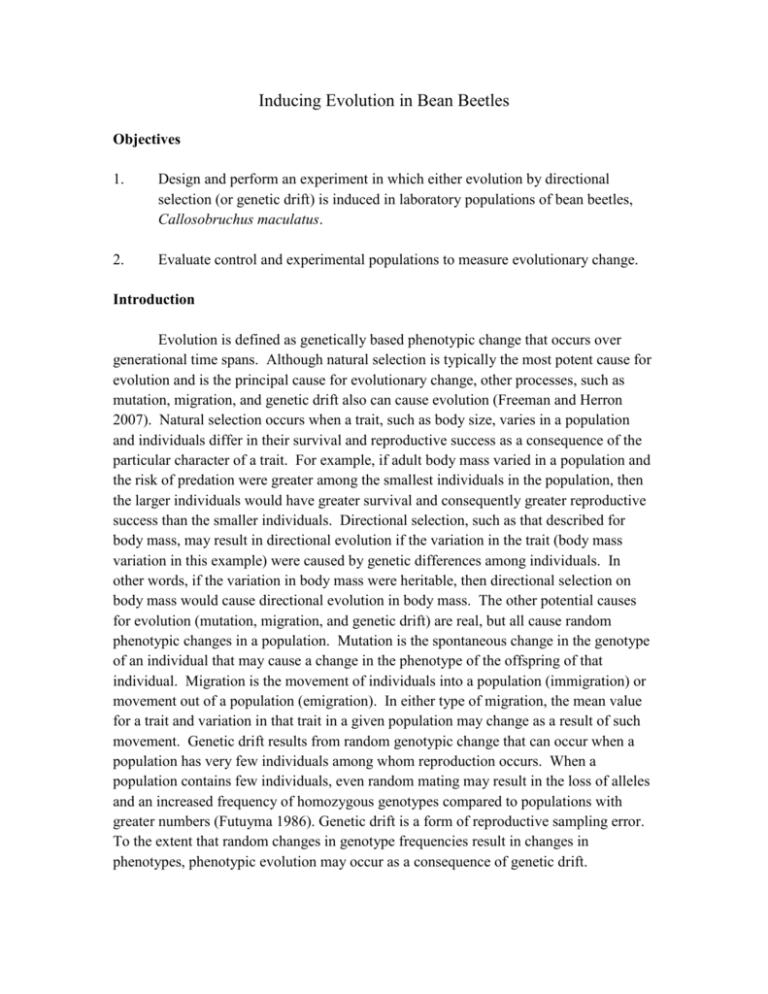
Inducing Evolution in Bean Beetles Objectives 1. Design and perform an experiment in which either evolution by directional selection (or genetic drift) is induced in laboratory populations of bean beetles, Callosobruchus maculatus. 2. Evaluate control and experimental populations to measure evolutionary change. Introduction Evolution is defined as genetically based phenotypic change that occurs over generational time spans. Although natural selection is typically the most potent cause for evolution and is the principal cause for evolutionary change, other processes, such as mutation, migration, and genetic drift also can cause evolution (Freeman and Herron 2007). Natural selection occurs when a trait, such as body size, varies in a population and individuals differ in their survival and reproductive success as a consequence of the particular character of a trait. For example, if adult body mass varied in a population and the risk of predation were greater among the smallest individuals in the population, then the larger individuals would have greater survival and consequently greater reproductive success than the smaller individuals. Directional selection, such as that described for body mass, may result in directional evolution if the variation in the trait (body mass variation in this example) were caused by genetic differences among individuals. In other words, if the variation in body mass were heritable, then directional selection on body mass would cause directional evolution in body mass. The other potential causes for evolution (mutation, migration, and genetic drift) are real, but all cause random phenotypic changes in a population. Mutation is the spontaneous change in the genotype of an individual that may cause a change in the phenotype of the offspring of that individual. Migration is the movement of individuals into a population (immigration) or movement out of a population (emigration). In either type of migration, the mean value for a trait and variation in that trait in a given population may change as a result of such movement. Genetic drift results from random genotypic change that can occur when a population has very few individuals among whom reproduction occurs. When a population contains few individuals, even random mating may result in the loss of alleles and an increased frequency of homozygous genotypes compared to populations with greater numbers (Futuyma 1986). Genetic drift is a form of reproductive sampling error. To the extent that random changes in genotype frequencies result in changes in phenotypes, phenotypic evolution may occur as a consequence of genetic drift. In this study, you will design and conduct experiments to induce evolutionary change in an insect species, bean beetles (cowpea seed beetles), Callosobruchus maculatus. Bean beetles are agricultural pest insects of Africa and Asia. Females lay their eggs on the surface of beans (Family Fabaceae). Eggs are deposited (=oviposition) singly and several days after oviposition, a beetle larva (maggot) burrows into the bean. At 30°C, pupation and emergence of an adult beetle occurs 25-30 days after an egg was deposited. Adults are mature 24 - 36 hours after emergence and they do not need to feed. Adults may live for 7-10 days during which time mating and oviposition occurs (Mitchell 1975). Adult body mass, linear body dimensions, and egg-to-adult development-time are variable traits in C. maculatus. Consequently, these easily measured traits are candidates for inducing evolutionary change in laboratory populations. Previous studies have found that variation in body mass is heritable in both sexes but failed to find heritable variation in egg-to-adult development-time (Fox et al 2004). Experimental Design Your instructor will announce the focus of your study, either inducing evolution by natural selection or genetic drift. Address the following questions. Come to class ready to discuss your answers. What is the importance of trait variation if you were to induce natural selection? Design an experiment or set of experiments to test the hypothesis that you can induce evolution in a trait by natural selection or genetic drift. What assumption must you make about the cause for trait variation if selection were to result in evolution? Can natural selection result in evolution in a trait if variation were caused entirely by environmental variation? For each of the experiments you designed above, you should: predict the possible outcomes for the experiment that would support your hypothesis identify and list the variables you would manipulate in your experiment identify and list the variables you would keep constant in your experiment list the data you would collect to determine if your predictions were true Literature Cited Fox, C.W., M.L. Bush, D.A. Roff, and W.G. Wallin. 2004. Evolutionary genetics of lifespan and mortality rates in two populations of seed beetles, Callosobruchus maculatus. Heredity 92:170-181. Freeman, S. and J.C. Herron. 2007. Evolutionary Analysis. 4th edition. Benjamin Cummings. 800 pages. Mitchell, R. 1975. The evolution of oviposition tactics in the bean weevil, Callosobruchus maculatus F. Ecology 56:696-702. Futuyma, D.J. 1986. Evolutionary Biology. Second edition. Sinauer Associates. 600 pages. This study was written by L. Blumer and C. Beck 2008 (www.beanbeetles.org).


